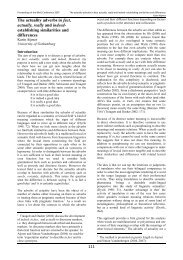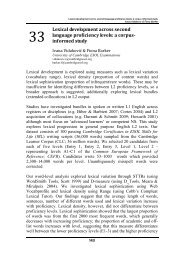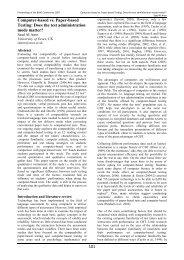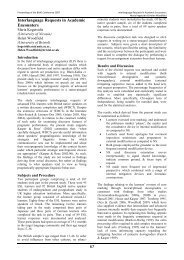Proceedings of the - British Association for Applied Linguistics
Proceedings of the - British Association for Applied Linguistics
Proceedings of the - British Association for Applied Linguistics
Create successful ePaper yourself
Turn your PDF publications into a flip-book with our unique Google optimized e-Paper software.
The Impact <strong>of</strong> <strong>Applied</strong> <strong>Linguistics</strong>: <strong>Proceedings</strong> <strong>of</strong> <strong>the</strong> 44th Annual Meeting <strong>of</strong> BAAL<br />
University <strong>of</strong> <strong>the</strong> West <strong>of</strong> England<br />
Essentially, this communications unit seems bent on <strong>for</strong>cing its own<br />
vacuous PR way <strong>of</strong> using language onto academics.<br />
PR language<br />
What do I mean by <strong>the</strong> PR way <strong>of</strong> using language? That is beyond <strong>the</strong><br />
scope <strong>of</strong> this article, but <strong>the</strong>re are some general characteristics which have<br />
been noted by sociologists (Moloney 2006) and by applied linguists who<br />
have studied it (Cook 2004:62-75, 2008, Mautner 2010a, 2010b). PR<br />
language is distinctive at both <strong>the</strong> macro and <strong>the</strong> micro level.<br />
At <strong>the</strong> macro level, prototypical PR is primarily intended to present an<br />
individual or an organisation in a favourable light. The overarching<br />
characteristics seem to be vagueness, lack <strong>of</strong> precision, and <strong>the</strong> presentation<br />
only <strong>of</strong> positive points, without acknowledgement <strong>of</strong> any weaknesses or<br />
counter argument. As in <strong>the</strong> propaganda <strong>of</strong> totalitarian regimes from which<br />
it directly descends (Moloney 2006:41-57), all news is good news, every<br />
harvest is a bumper harvest, and all workers are happy.<br />
At <strong>the</strong> micro level, <strong>the</strong>se overarching characteristics are realised through a<br />
number <strong>of</strong> linguistic strategies, 1 such as imprecise pre-modifiers (many<br />
people), modal hedges (may contribute) lack <strong>of</strong> detail (a poll in 2005),<br />
evaluative terms with imprecise denotation (beneficial to our customers<br />
and to <strong>the</strong> environment, thoughtful and effective stewardship); intensifiers<br />
(we place strong emphasis on personal accountability); measures,<br />
comparatives and superlatives without reference points (fewer calories);<br />
mitigators <strong>of</strong> numerals (Some 10 million people shop with us each week in<br />
over 375 stores), superfluous qualifiers, (Simply tell us where you want to<br />
go), word class conversion (we aim to deliver best-in-class financial<br />
results) and strange metaphors, such as <strong>the</strong> agricultural ones used about<br />
research (pump-priming, drilling down, hubs, seed-corn, silos, sandpits etc)<br />
(Cook 2007; Cook, Reed and Twiner 2009).<br />
Is this a use <strong>of</strong> language which rigorous academic study should imitate?<br />
The PR discourse which academics are being urged to use is surely at odds<br />
with <strong>the</strong> ideals <strong>of</strong> academic discourse: precision, disinterestedness,<br />
constructive disagreement, objectivity, self-criticism, freedom to dissent<br />
from <strong>the</strong> corporate view.<br />
It is not surprising <strong>of</strong> course that university communications units do not<br />
consult applied linguists on issues to do with language use and<br />
effectiveness, and I am not suggesting that <strong>the</strong>y should. <strong>Applied</strong> linguists<br />
48







